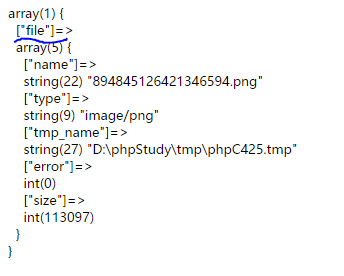
The example of this article analyzes the PHP file upload operation. Share it with everyone for your reference, the details are as follows:
File upload
occurs in the request sent by the browser to the server.
File, for the browser, is just a special type of data in the form.
Data in the browser form, two types:
String type (byte stream encoding)
File type (binary encoding), the file is in the form data Part of
Server perspective:
Process the data in the form when accepting the browser request. Different processing methods are used according to different data types:
String type, stored in the $_POST variable (memory)
File type data, stored in the upload temporary directory
When the form is submitted, the browser will behave as follows:
The content in the form is of string type. Even if a file field is added, attributes need to be added to the form to inform the browser that more than just strings are uploaded. type data. enctype="multipart/form-data"
<body>
<form action="upload.php" method="post" enctype="multipart/form-data">
<input type="file" name="file">
</br>
<input type="submit" value="submit">
</form>
</body>After the php server receives the form data of the file type, it stores the file in a temporary directory (it is a temporary file and is valid within the script cycle)
; Temporary directory for HTTP uploaded files (will use system default if not ; specified). ; http://php.net/upload-tmp-dir ;upload_tmp_dir =
Persistently store temporary files
move_uploaded_file(src_url,goa_url)
$_FILES, which stores uploaded file information including temporary addresses

Error type:
0-1-2-3-4-6-7
0 means there is no error
1 means the file is larger than the php setting
; Maximum allowed size for uploaded files. ; http://php.net/upload-max-filesize upload_max_filesize = 2M
2 means the file is larger than the form setting max_file_size
<input type='hidden' name='MAX_FILE_SIZE' value='1024'>
3 means that the file upload is incomplete
4 means that no file is uploaded
5 means that a 0-byte file (empty file) is logically uploaded
6 means the temporary upload directory was not found (insufficient permissions)
7 means file writing failed (disk space, permissions)
Maximum number of uploaded files allowed by php
; Maximum number of files that can be uploaded via a single request max_file_uploads = 20
There is a maximum value limit for post
Once exceeded, PHP cannot process post and file values normally and may be empty values
; Maximum size of POST data that PHP will accept. ; http://php.net/post-max-size post_max_size = 8M
In type detection
The suffix name and mime are both browse Provided by the server, PHP extension fileinfo is required to complete the check of file information (function process and object-oriented)
;extension=php_fileinfo.dll
$finfo = new Finfo(FILEINFO_MIME_TYPE); $mine_type = $finfo->file($file['tmp_name']);
Molecular directory storage uploaded files
Principle: business logic, number of files, time
Create directory mkdir()
Check directory is_dir()
<?php
upload($_FILES['file']);
function upload($file){
if($file['error']!=0){
return false;
}
//3M
$max_size = 3145728;
if($max_size<$file['size']){
return false;
}
//设置一个后缀名与mime的映射关系
$type_map = array(
'.jpeg'=>array('image/jpeg','image/pjpeg'),
'.jpg'=>array('image/jpeg','image/pjpeg'),
'.png'=>array('image/png','image/x-png'),
'.gif'=>array('image/gif')
);
//后缀
$allow_ext_list = array('.jpeg','.png','.jpg');
$ext = strtolower(strrchr($file['name'],'.'));
if(!in_array($ext,$allow_ext_list)){
echo '不支持该图片格式';
return false;
}
//MIME
$allow_mime_list = array();
foreach($allow_ext_list as $val){
$allow_mime_list = array_merge($allow_mime_list,$type_map[$val]);
}
//浏览器提供信息坚持
$allow_mime_list = array_unique($allow_mime_list);
if(!in_array($file['type'],$allow_mime_list)){
echo '不支持该图片格式';
return false;
}
//php自身检查
$file_mime = new Finfo(FILEINFO_MIME_TYPE);
$mime = $file_mime->file($file['tmp_name']);
if(!in_array($mime,$allow_mime_list)){
echo '不支持该图片格式';
return false;
}
//目录存储
$up_loadpath = './';
$sub_dir = date('Ymdh');
if(!is_dir($up_loadpath.$sub_dir)){
mkdir($up_loadpath.$sub_dir);
}
$prefix = 'bee_';
$name = uniqid($prefix,true).$ext;
if(move_uploaded_file($file['tmp_name'],$up_loadpath.$sub_dir.$name)){
echo '上传成功';
return $name;
}else{
echo '上传失败';
return false;
}
}I hope this article will be useful to everyone in PHP programming. helped.
For more detailed PHP file upload operation examples and related articles, please pay attention to the PHP Chinese website!
 Ethereum browser blockchain query
Ethereum browser blockchain query
 What to do if the computer desktop icon cannot be opened
What to do if the computer desktop icon cannot be opened
 What is the difference between database views and tables
What is the difference between database views and tables
 How to use python for loop
How to use python for loop
 What currency does USDT belong to?
What currency does USDT belong to?
 How to turn off WeChat automatic download
How to turn off WeChat automatic download
 Full-width symbol input tutorial
Full-width symbol input tutorial
 Build an Internet server
Build an Internet server




